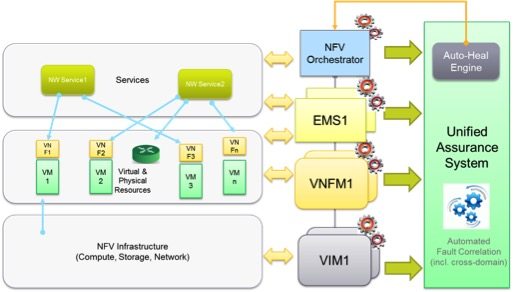Wipro sees great change and opportunity in network assurance from NFV deployments
Network functions virtualization has brought the capability of the telco networks on commodity hardware and software. Never before was the pace of change so fast and so disruptive. The question being asked today is whether the disruptions brought on by these technologies will create a paradigm shift in the way networks are being operated. Another question is how NFV will actually result in significant savings for service providers on capital expense and operating expense. This column focuses on the network fault management area and how it is impacted for providing assurance for virtualized and hybrid networks.
Impact on operations and systems
Telecom networks today are operated and managed by network operations team, consisting of monitoring teams, field engineers and level two and three experts, which are organized around types of network, services and so on. Both IT and network operations are handled in silos, with duplicate setups and teams created for managing the same. We shall see that NFV will have both qualitative and quantitative impact on these teams. These teams, smaller in size in the future, may need to get familiar with both IT and network operations.
With NFV, the physical network will start getting augmented with virtual networks. There will be co-existence of these hybrid networks for some time with new virtual networks before the physical networks see a trend of getting completely marginalized. In the context of network assurance, one would require additional instrumentation for visibility on the whole new virtual setup that gets created for delivering the virtual network functions, which is limited with existing legacy tools.
NFV and network assurance
As per the European Telecommunications Standards Institute’s ISG Management and Network Operations framework, the virtual infrastructure manager that manages NFVI resources within a domain and the VNF Manager that performs orchestration and management function of various VNFs, will both support complete fault, configuration, accounting, performance and security capabilities. The framework also has a NFV orchestrator that performs orchestration and management of NFVI resources across multiple VIMs and interacts with operating support and business support systems or provisioning, activation, capacity management and so on.
In the initial phases, the strategy or toolsets for monitoring of NFV will not be significantly different from what is currently available for the physical networks. The NFV infrastructure (compute, storage and network), VM and VNF related faults will be collected through following means:
• Direct SNMP-based monitoring of the underlying physical infrastructure (e.g. Esxi hosts).
• VIMs may be an alternate source of respective fault and performance alarms to OSS systems.
• Both element managers and VNF managers will be the source of alarms. They have overlapping capabilities today, however one significant difference between the two is that while element managers implement proprietary interfaces for managing their respective VNFs, VNF managers will do the same with industry standard interfaces.
• Other sources would be system logs, process and services monitoring through URL and port monitoring.
• Native management APIs of the leading cloud or virtual environment will provide further insights into the internal working of these environments. Many of the commercial and open-source tools have already announced availability of these monitoring packs in their respective solution.
• New analyzers and agents are being developed that would be located in strategic locations in the virtualized environment and be able to capture the packets flowing across the network to provide insights into working of complex use cases involving multitier services and applications.
Fault management evolution and implications for network availability
The faults that emanate in the physical world typically require a lot of manual intervention. The capacity issue or hardware related faults in the physical environment are the ones that require manual trouble-shooting, visits by field engineers, etc.
However, in the virtual environment, due to in-built resiliency in the environment, these manual activities can be completely done away with. Further, VIMs and VNF managers are designed to have comprehensive configuration management capabilities of their respective domain, which can be leveraged to fix the Infrastructure issues dynamically in real time, remotely and even without manual intervention.
One can foresee each of these VIMs and VNF managers will be enhanced to have a separate in-built resolution modules that would trigger a corrective action based on alarms generated at the NFVI layer and VM/VNF layer. Over a period of time with advance analytics capabilities further augmented in these systems, these will be able to identify not only the issues proactively but also will be able to trigger a series of actions to avoid a larger system impact. This system will also get further enhanced with an auto-healing engine that would trigger certain corrective actions through the NFV orchestrator resulting in a truly “self-healing” network.
Doing fault correlation in a virtual environment will be a complex task as there exist many-to-many relations between VNFs to VMs to underlying physical resources. Secondly, network services get orchestrated through complex service function chaining or VNF forwarding graphs across both VNFs/PNFs. In this scenario, a network service being provided through multiple service providers deployed in multiple data centers will add to the complexity, but due to above self-healing engine the noise will get drastically reduced enabling faster or auto resolution.

Figure 1: Future unified fault assurance system.
Conclusion
It is a matter of time until inherent resilience of virtual environment, automated workflows and corrective actions within the VIMs or VNF managers or OSS assurance systems as described above will be able to solve significant number of the problems dynamically. This will result in major effort reduction in the network assurance operations.
Therefore, NFV as a technology is not only going to impact the capex for acquisition of new networks and services, but is also going to have a far reaching implication of reducing opex for the network organizations.
The current industry collaboration is bringing these changes at breakneck speed. It is important for operators and service providers to align their focus for achieving the benefits of this technology.
Abhinav Anand is a consulting partner in the OSS-BSS practice team of Global Media & Telecom vertical at Wipro. He has played various roles like head-OSS design and solution architect in various customer delivery engagements. Anand has 19 years of experience, 15 of which have been in the network and OSS-BSS space for telecom customers. Anand is TOGAF Foundation certified and has detailed knowledge and experience of industry/telecom standard processes and frameworks like eTOM and ITIL. Anand holds engineering and management degrees from premier institutes.
Editor’s Note: In an attempt to broaden our interaction with our readers we have created this Reader Forum for those with something meaningful to say to the wireless industry. We want to keep this as open as possible, but we maintain some editorial control to keep it free of commercials or attacks. Please send along submissions for this section to our editors at: dmeyer@rcrwireless.com.

